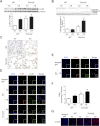TLR4 deficiency promotes autophagy during cigarette smoke-induced pulmonary emphysema
- PMID: 22983353
- PMCID: PMC3517684
- DOI: 10.1152/ajplung.00102.2012
TLR4 deficiency promotes autophagy during cigarette smoke-induced pulmonary emphysema
Abstract
Toll-like receptors (TLRs) exert important nonimmune functions in lung homeostasis. TLR4 deficiency promotes pulmonary emphysema. We examined the role of TLR4 in regulating cigarette smoke (CS)-induced autophagy, apoptosis, and emphysema. Lung tissue was obtained from chronic obstructive lung disease (COPD) patients. C3H/HeJ (Tlr4-mutated) mice and C57BL/10ScNJ (Tlr4-deficient) mice and their respective control strains were exposed to chronic CS or air. Human or mouse epithelial cells (wild-type, Tlr4-knockdown, and Tlr4-deficient) were exposed to CS-extract (CSE). Samples were analyzed for TLR4 expression, and for autophagic or apoptotic proteins by Western blot analysis or confocal imaging. Chronic obstructive lung disease lung tissues and human pulmonary epithelial cells exposed to CSE displayed increased TLR4 expression, and increased autophagic [microtubule-associated protein-1 light-chain-3B (LC3B)] and apoptotic (cleaved caspase-3) markers. Beas-2B cells transfected with TLR4 siRNA displayed increased expression of LC3B relative to control cells, basally and after exposure to CSE. The basal and CSE-inducible expression of LC3B and cleaved caspase-3 were elevated in pulmonary alveolar type II cells from Tlr4-deficient mice. Wild-type mice subjected to chronic CS-exposure displayed airspace enlargement;, however, the Tlr4-mutated or Tlr4-deficient mice exhibited a marked increase in airspace relative to wild-type mice after CS-exposure. The Tlr4-mutated or Tlr4-deficient mice showed higher levels of LC3B under basal conditions and after CS exposure. The expression of cleaved caspase-3 was markedly increased in Tlr4-deficient mice exposed to CS. We describe a protective regulatory function of TLR4 against emphysematous changes of the lung in response to CS.
Figures





References
-
- Barnes PJ. Chronic obstructive pulmonary disease. N Engl J Med 343: 269–280, 2000 - PubMed
-
- Bertin A, Samson M, Pons C, Guigonis JM, Gavelli A, Baqué P, Brossette N, Pagnotta S, Ricci JE, Pierrefite-Carle V. Comparative proteomics study reveals that bacterial CpG motifs induce tumor cell autophagy in vitro and in vivo. Mol Cell Proteomics 7: 2311–2322, 2008 - PubMed
-
- Chen ZH, Kim HP, Sciurba FC, Lee SJ, Feghali-Bostwick C, Stolz DB, Dhir R, Landreneau RJ, Schuchert MJ, Yousem SA, Nakahira K, Pilewski JM, Lee JS, Zhang Y, Ryter SW, Choi AM. Egr-1 regulates autophagy in cigarette smoke-induced chronic obstructive pulmonary disease. PLoS One 3: e3316, 2008 - PMC - PubMed
Publication types
MeSH terms
Substances
Grants and funding
LinkOut - more resources
Full Text Sources
Medical
Molecular Biology Databases
Research Materials

